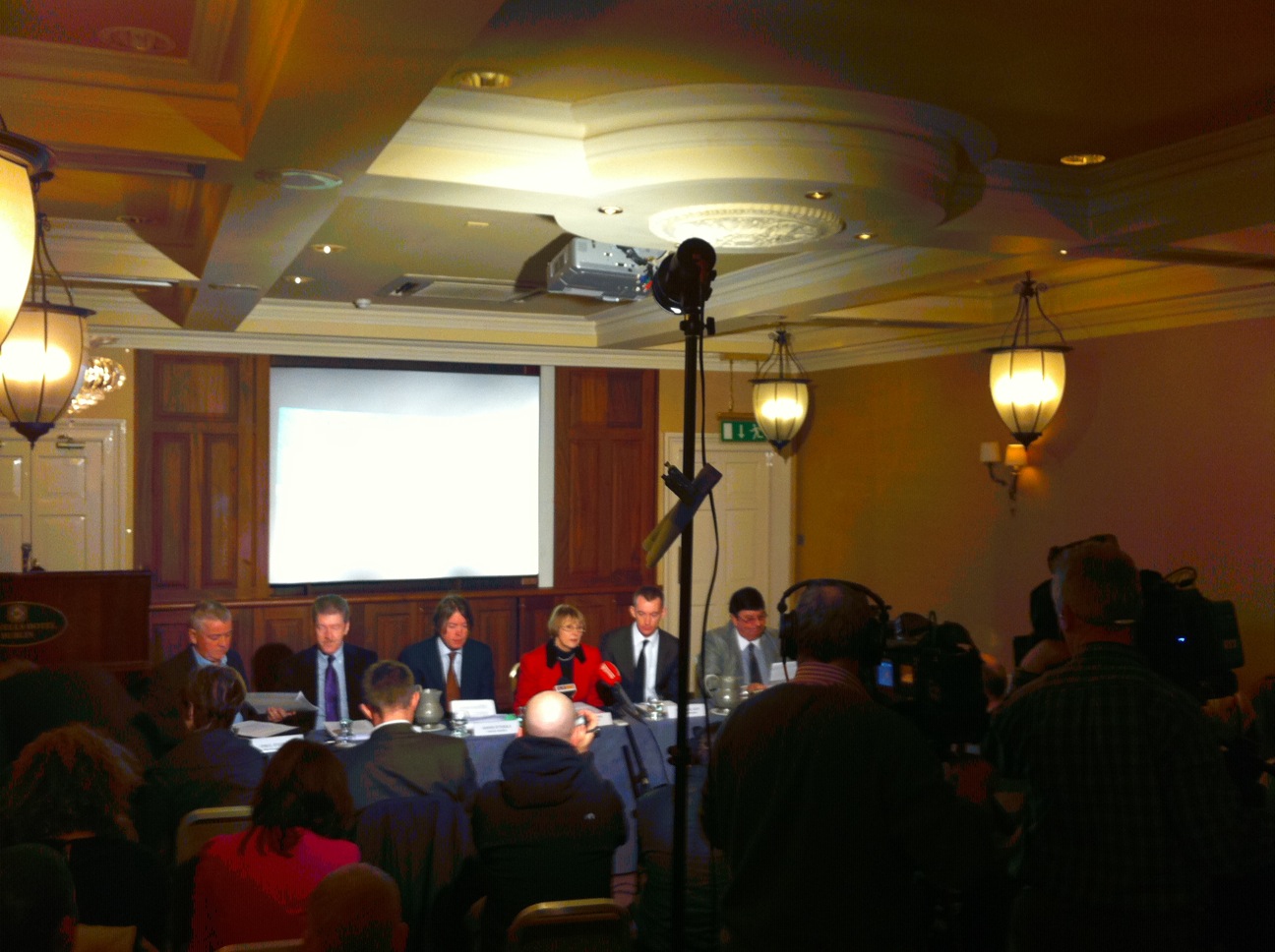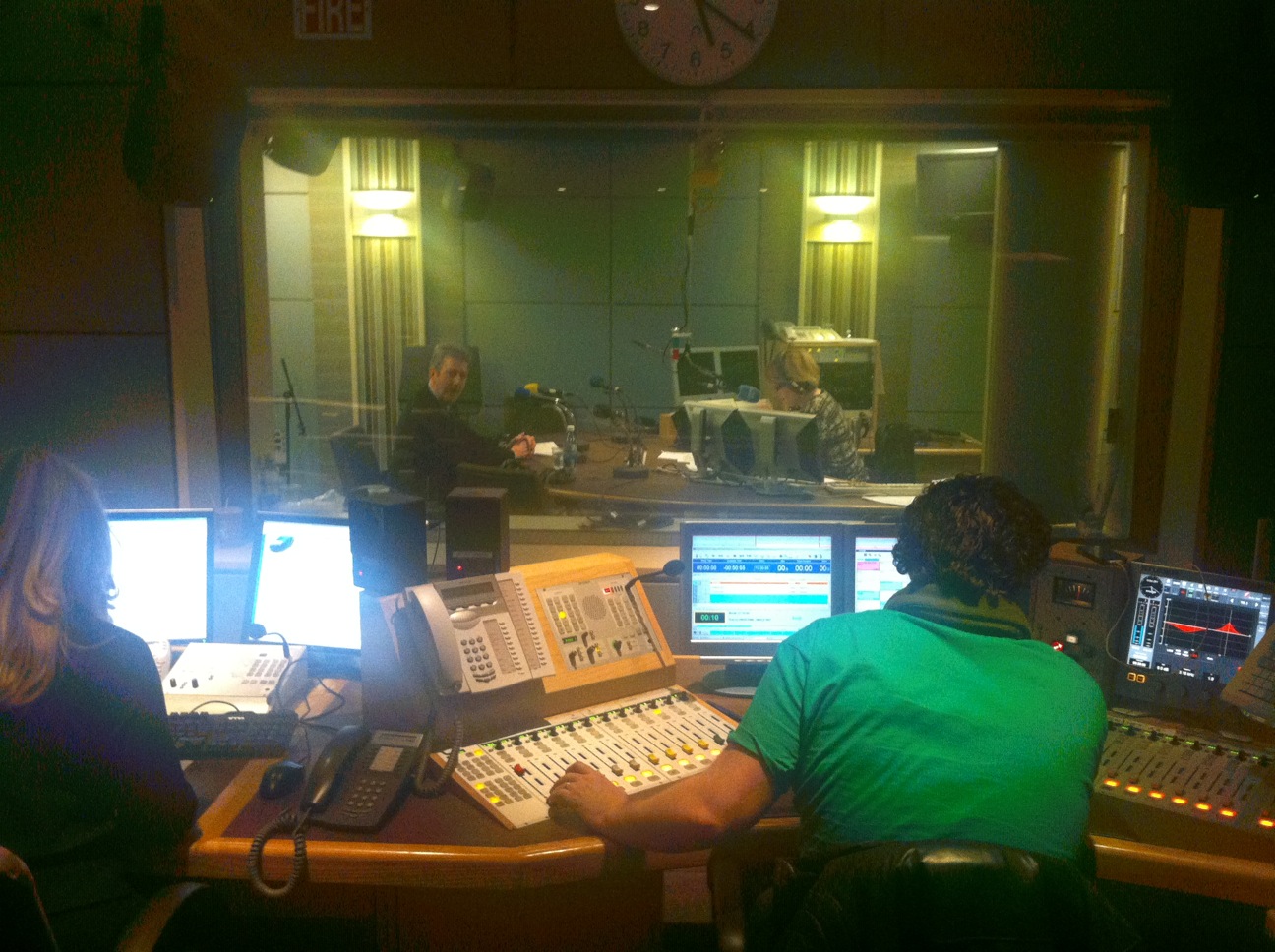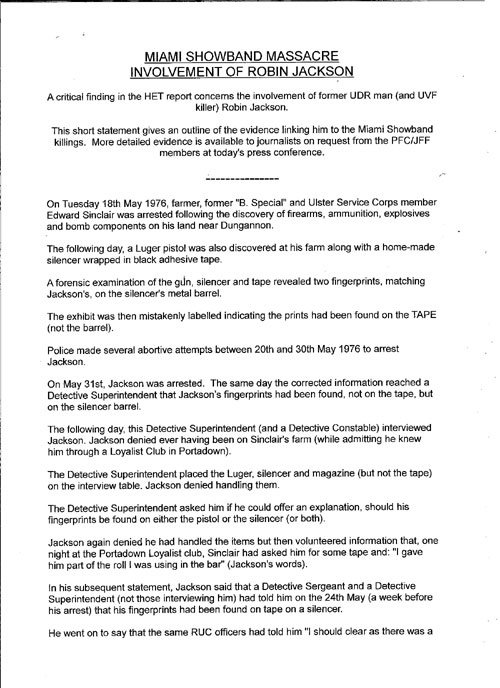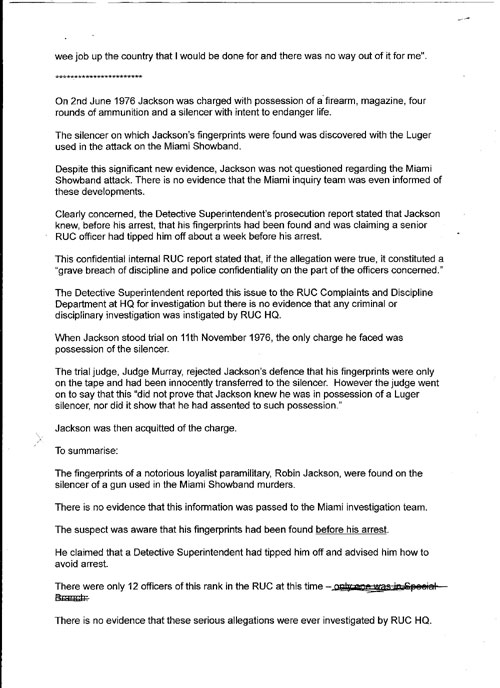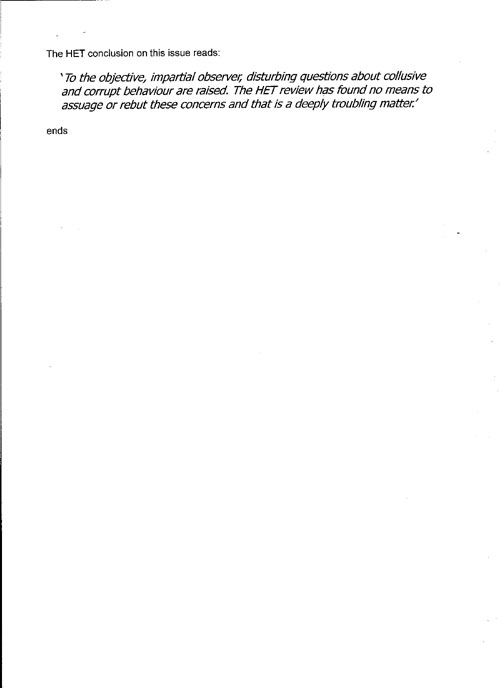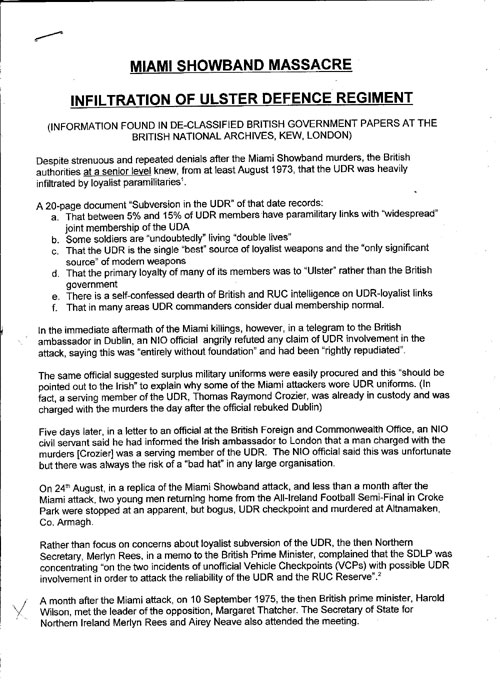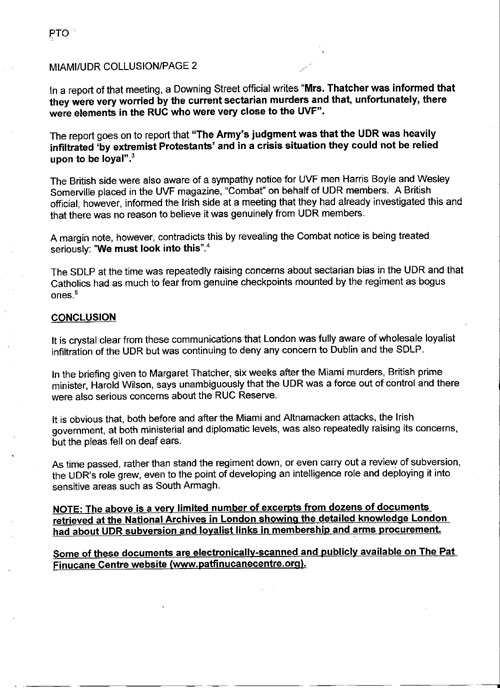Historical Enquiries Team report into The Miami Showband Massacre
Justice is the implementation of man-made laws.
Truth is the DNA of civilisation – Stephen Travers
14th December 2011. Today’s press conference in Dublin organised by Margaret Urwin of The Pat Finucane Centre / Justice For The Forgotten enabled survivors Stephen Travers and Des McAlea and the families of those murdered; Fran O’Toole, Brian McCoy and Tony Geraghty of The Miami Showband to give their reaction to the Police Service of Northern Ireland’s Historical Enquiries Team report into The Miami Showband Massacre.
Nobody is saying every single member of the UDR engaged in collusion but what is clear is that there is a very systemic relationship between the UDR and loyalist paramilitaries and that the British government were compelled to put the facts in a classified document stating they would be disloyal to the government if shove came to push. What did the government do at the time? They did nothing. They let, they acquiesced in this and they let this occur and that’s appalling.
What we need is a (sic) today is one case and a hugely important case. What we need is an independent truth recovery process that addresses every incident in a collective way equally and addresses the whole issue of collusion, state violence and violence by other organisations.
Mary Wilson of RTE’s Drivetime
discusses with Paul O’Connor of The Pat Finucane Centre
the PSNI Historical Enquiries Team Report
into The Miami Showband Massacre.
(c) Copyright RTE – Get the latest RTE News on The Miami Showband massacre.
Mary Wilson of RTE’s Drivetime
discusses with Stephen Travers of The Miami Showband
the PSNI Historical Enquiries Team Report
into The Miami Showband Massacre.
(c) Copyright RTE – Get the latest RTE News on The Miami Showband massacre.
(c) Copyright The Three Amigos
RTE News – 14th December 2011
(c) Copyright RTE – Get the latest RTE News on The Miami Showband massacre.
UTV Live – 15th December 2011
(c) Copyright UTV – Get the latest UTV News on The Miami Showband massacre
The Morning Show – 22nd December 2011
(c) Copyright The Morning Show
Tonight With Vincent Brown
(c) Copyright Tonight With Vincent Brown
Documents relating to the HET Report
A critical finding in the HET report concerns the involvement of former UDR man (and UVF killer) Robin Jackson.
This short statement gives an outline of the evidence linking him to the Miami Showband killings. More detailed evidence is available to journalists on request from the PFC/JFF members at today’s press conference.
On Tuesday 18th May 1976, farmer, former “B. Special” and Ulster Service Corps member Edward Sinclair was arrested following the discovery of firearms, ammunition, explosives and bomb components on his land near Dungannon. The following day, a Luger pistol was also discovered at his farm along with a home-made silencer wrapped in black adhesive tape. A forensic examination of the gun, silencer and tape revealed two fingerprints, matching Jackson’s, on the silencer’s metal barrel.
The exhibit was then mistakenly labelled indicating the prints had been found on the TAPE (not the barrel).
Police made several abortive attempts between 20th and 30th May 1976 to arrest Jackson.
On May 31st, Jackson was arrested. The same day the corrected information reached a Detective Superintendent that Jackson’s fingerprints had been found, not on the tape, but on the silencer barrel.
The following day, this Detective Superintendent (and a Detective Constable) interviewed Jackson. Jackson denied ever having been on Sinclair’s farm (while admitting he knew him through a Loyalist Club in Portadown).
The Detective Superintendent placed the Luger, silencer and magazine (but not the tape) on the interview table. Jackson denied handling them.
The Detective Superintendent asked him if he could offer an explanation, should his fingerprints be found on either the pistol or the silencer (or both).
Jackson again denied he had handled the items but then volunteered information that, one night at the Portadown Loyalist club, Sinclair had asked him for some tape and: “l gave him part of the roll I was using in the bar” (Jackson’s words).
ln his subsequent statement, Jackson said that a Detective Sergeant and a Detective Superintendent (not those interviewing him) had told him on the 24th May (a week before his arrest) that his fingerprints had been found on tape on a silencer.
He went on to say that the same RUC officers had told him “l should clear as there was a …
**********************
On 2nd June 1976 Jackson was charged with possession of a’firearm, magazine, four rounds of ammunition and a silencer with intent to endanger life.
The silencer on which Jackson’s fingerprints were found was discovered with the Luger used in the attack on the Miami Showband.
Despite this significant new evidence, Jackson was not questioned regarding the Miami Showband attack. There is no evidence that the Miami inquiry team was even informed of these developments.
Clearly concemed, the Detective Superintendent’s prosecution report stated that Jackson knew, before his arrest, that his fingerprints had been found and was claiming a senior RUC officer had tipped him off about a week before his arrest.
This confidential internal RUC report stated that, if the allegation were true, it constituted a “grave breach of discipline and police confidentiality on the part of the officers concerned.”
The Detective Superintendent reported this issue to the RUC Complaints and Discipline Department at HQ for investigation but there is no evidence that any criminal or disciplinary investigation was instigated by RUC HQ.
When Jackson stood trial on 11th November 1976, the only charge he faced was possession of the silencer.
The trial judge, Judge Murray, rejected Jackson’s defence that his fingerprints were only on the tape and had been innocently transferred to the silencer. However the judge went on to say that this “did not prove that Jackson knew he was in possession of a Luger silencer, nor did it show that he had assented to such possession.”
Jackson was then acquitted of the charge.
To summarise:
The fingerprints of a notorious loyalist paramilitary Robin Jackson, were found on the silencer of a gun used in the Miami Showband murders.
There is no evidence that this information was passed to the Miami investigation team.
The suspect was aware that his fingerprints had been found before his arrest.
He claimed that a Detective Superintendent had tipped him off and advised him how to avoid arrest.
There were only 12 officers of this rank in the RUC at this time.
There is no evidence that these serious allegations were ever investigated by RUC HQ.
“To the objective, impartial observer disturbing questions about collusive and corrupt behaviour are raised, The HET review has found no means to assuage or rebut these conerns and that is a deply troubling matter.’
ends
(INFORMATTON FOUND lN DE-CLASSIFTED BRITISH GOVERNMENT PAPERS AT THE BRITISH NATIONAL ARCHIVES, KEW, LONDON)
Despite strenuous and repeated denials after the Miami Showband murders, the British authorities at a senior level knew, from at least August 1973, that the UDR was heavily infiltrated by loyalist paramilitaries.
A 2O-page document “Subversion in the UDR” of that date records: a.That between 5% and 15% of UDR members’have paramilitary links with “widespread joint membershiP of the UDA” b. Some soldiers are “undoubtedly living “double lives” c. That the UDR is the single “best” source of loyalist weapons and the “only significant source of modern weapons. d. That the primary loyalty of many of its members was to ‘Ulster’ rather than the British government. e. There is a self confessed dearth of British and RUC intelligence on UDR-loyalist links. f. That in many areas UDR commanders consider dual membership normal.
In the immediate aftermath of the Miami killings, however, in a telegram to the British ambassador in Dublin, an NIO official angrily refuted any claim of UDR involvement in the attack, saying this was “entirely without foundation” and had been “rightly repudiated”.
The same official suggested surplus military uniforms were easily procured and this’should be pointed out to the lrish” to eplain why some of the Miami attackers wore UDR uniforms. (In fact, a serving member of the UDR, Thomas Raymond Crozier, was already in custody and was charged with the murder the day after the official rebuked Dublin)
Five days later, in a letter to an official at the British Foreign and Commonwealth Office, an NIO civil servant said he had informed the lrish ambassador to London that a man charged with the murders [Crozier] was a serving member of the UDR. The NIO official said this was unfortunate but there was always the risk of a “bad hat” in any large organisation.
On 24h August, in a replica of the Miami Showband attack, and less than a month after the Miami attack, two young men returning home ftom the All-lreland Football Semi-Final in Croke Park were stopped at an apparent, but bogus, UDR checkpoint and murdered at Altanamaken, Co. Armagh.
Rather than focus on concerns about loyalist subversion of the UDR, the then Northern Secretary, Merlyn Rees, in a memo to the British Prime Minister, complained that the SDLP was concentrating “on the two incidents of unofficial Vehicle Checkpoints (VCPs) with possible UDR involvement in order to attack the reliability of the UDR and the RUC Reserve”.
A month after the Miami attack, on 10 September 1975, the then British prime minister, Harold Wilson, met the leader of the opposition, Margaret Thatcher. The Secretary of State for Northern lreland Merlyn Rees and Airey Neave also attended the meeting.
MIAMI/UDR COLLUSION PAGE 2
ln a report of that meeting, a Downing Street official writes “Mrs Thatcher was informed that they were very worried by the current sectarian murders and that unfortunately there were elements in the RUC who were very close to the UVF”.
The report goes on to report that “The Army’e iudgment wae that the UDR was heavily infiltrated by extremist Protestants’ and in a crisis situation they could not be relied upon to be loyal”.
The British side were also aware of a sympathy notice for UVF men Harris Boyle and Wesley Somerville placed in the UVF magazine, “Combat” on behalf of UDR members. A British official, however, informed the lrish side at a meeting that they had already investigated this and that there was no reason to believe it was genuinely from UDR members.
A margin note, however, contradicts this by revealing the Combat notice is being treated seriously: ‘We must look into this”.’
The SDLP at the time was repeatedly raising concerns about sectarian bias in the UDR and that Catholics had as much to fear from genuine checkpoints mounted by the regiment as bogus ones.
CONCLUSION
It is crystal clear from these communications that London was fully aware of wholesale loyalist infiltration of the UDR but was continuing to deny any concern to Dublin and the SDLP’
in the briefing given to Margaret Thatcher, six weeks after the Miami murders, British prime minister, Harold Wilson, says unambiguously that the UDR was a force out of control and there were also serious concerns about the RUC Reserve.
It is obvious that, both before and after the Miami and Altnamacken attacks, the irish government, at both ministerial and diplomatic levels, was also repeatedly raising its concerns, but the pleas fell on deaf ears.
As time passed, rather than stand the regiment down, or even carry out a review of subversion, the UDR’s role grew, even to the point of developing an intelligence role and deploying it into sensitive areas such as South Armagh’
NOTE: The above is a very limited number of excerpts from dozens of documents retrieved at the National Archives in London showing the detailed knowledge London had about UDR subversion and loyalist links in membership and arms procurement.
Some of these documents are electronically-scanned and publicly available on The Pat Finucane Centre website (www.patfinucanecentre.org).
Links:
The Guardian – Police tip-off helped suspect elude justice, says report
BBC – Miami Showband massacre: HET raises collusion concerns
Ulster TV – Collusion questions in Miami murders
Inside Ireland.ie – HET raises collusion concernes over Miami Showband killings
Broadsheet.ie – Miami Showband Massacre Report
Irish Examiner – Collusion not ruled out in Miami Showband massacre
Irish Independent – Detectives cannot rule out state collusion in Miami Showband massacre

